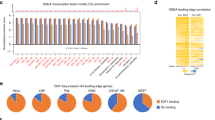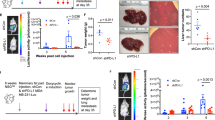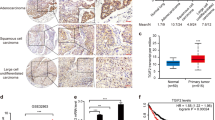Abstract
Tumor suppressor genes and the immune system are critical players in inhibiting cancer initiation and/or progression. However, little is known about whether a tumor suppressor gene can function through both immune-dependent and -independent mechanisms. Retinoic acid receptor responder 2 (RARRES2) is transcriptionally downregulated in multiple cancer types. Previous studies suggested that it can serve as an immune-dependent tumor suppressor by acting as a chemoattractant to recruit anticancer immune cells expressing its receptor, the chemerin chemokine receptor 1 (CMKLR1), to sites of tumor. In this study, we investigated the role of RARRES2 in adrenocortical carcinoma (ACC), a rare lethal malignancy in which aberrant Wnt/β-catenin signaling is frequently detected. We show that RARRES2 expression is downregulated in ACC as compared with normal and benign adrenocortical tissues, which is a result of CpG hypermethylation. Despite minimal CMKLR1 expression and lack of phenotypic tumor-suppressive effect with exogenous RARRES2 treatment, RARRES2 overexpression in ACC cell lines not only reduced cell proliferation, cell invasion and tumorigenicity in vitro, but also inhibited tumor growth in vivo in two immunodeficient mouse xenograft models. Mechanistically, RARRES2 overexpression in ACC cells inhibited Wnt/β-catenin pathway activity by promoting β-catenin phosphorylation and degradation, it also inhibited the phosphorylation of p38 mitogen-activated protein kinase. Thus our study identifies RARRES2 as a novel tumor suppressor for ACC, which can function through an immune-independent mechanism.
This is a preview of subscription content, access via your institution
Access options
Subscribe to this journal
Receive 50 print issues and online access
$259.00 per year
only $5.18 per issue
Buy this article
- Purchase on Springer Link
- Instant access to full article PDF
Prices may be subject to local taxes which are calculated during checkout






Similar content being viewed by others
References
Sherr CJ . Principles of tumor suppression. Cell 2004; 116: 235–246.
Finn OJ . Immuno-oncology: understanding the function and dysfunction of the immune system in cancer. Ann Oncol 2012; 23: viii6–viii9.
Bilimoria KY, Shen WT, Elaraj D, Bentrem DJ, Winchester DJ, Kebebew E et al. Adrenocortical carcinoma in the United States: treatment utilization and prognostic factors. Cancer 2008; 113: 3130–3136.
Kerkhofs TM, Verhoeven RH, Van der Zwan JM, Dieleman J, Kerstens MN, Links TP et al. Adrenocortical carcinoma: a population-based study on incidence and survival in the Netherlands since 1993. Eur J Cancer 2013; 49: 2579–2586.
Fassnacht M, Allolio B . Clinical management of adrenocortical carcinoma. Best Pract Res Clin Endocrinol Metab 2009; 23: 273–289.
Fassnacht M, Kroiss M, Allolio B . Update in adrenocortical carcinoma. J Clin Endocrinol Metab 2013; 98: 4551–4564.
Wittamer V, Franssen JD, Vulcano M, Mirjolet JF, Le Poul E, Migeotte I et al. Specific recruitment of antigen-presenting cells by chemerin, a novel processed ligand from human inflammatory fluids. J Exp Med 2003; 198: 977–985.
Ernst MC, Sinal CJ . Chemerin: at the crossroads of inflammation and obesity. Trends Endocrinol Metab 2010; 21: 660–667.
Wittamer V, Bondue B, Guillabert A, Vassart G, Parmentier M, Communi D . Neutrophil-mediated maturation of chemerin: a link between innate and adaptive immunity. J Immunol 2005; 175: 487–493.
Zabel BA, Silverio AM, Butcher EC . Chemokine-like receptor 1 expression and chemerin-directed chemotaxis distinguish plasmacytoid from myeloid dendritic cells in human blood. J Immunol 2005; 174: 244–251.
Vermi W, Riboldi E, Wittamer V, Gentili F, Luini W, Marrelli S et al. Role of ChemR23 in directing the migration of myeloid and plasmacytoid dendritic cells to lymphoid organs and inflamed skin. J Exp Med 2005; 201: 509–515.
Goralski KB, McCarthy TC, Hanniman EA, Zabel BA, Butcher EC, Parlee SD et al. Chemerin, a novel adipokine that regulates adipogenesis and adipocyte metabolism. J Biol Chem 2007; 282: 28175–28188.
Bozaoglu K, Bolton K, McMillan J, Zimmet P, Jowett J, Collier G et al. Chemerin is a novel adipokine associated with obesity and metabolic syndrome. Endocrinology 2007; 148: 4687–4694.
Velazquez-Fernandez D, Laurell C, Geli J, Hoog A, Odeberg J, Kjellman M et al. Expression profiling of adrenocortical neoplasms suggests a molecular signature of malignancy. Surgery 2005; 138: 1087–1094.
Fernandez-Ranvier GG, Weng J, Yeh RF, Khanafshar E, Suh I, Barker C et al. Identification of biomarkers of adrenocortical carcinoma using genomewide gene expression profiling. Arch Surg 2008; 143: 841–846 discussion 846.
Zheng Y, Luo S, Wang G, Peng Z, Zeng W, Tan S et al. Downregulation of tazarotene induced gene-2 (TIG2) in skin squamous cell carcinoma. Eur J Dermatol 2008; 18: 638–641.
Lin W, Chen YL, Jiang L, Chen JK . Reduced expression of chemerin is associated with a poor prognosis and a lowed infiltration of both dendritic cells and natural killer cells in human hepatocellular carcinoma. Clin Lab 2011; 57: 879–885.
Pachynski RK, Zabel BA, Kohrt HE, Tejeda NM, Monnier J, Swanson CD et al. The chemoattractant chemerin suppresses melanoma by recruiting natural killer cell antitumor defenses. J Exp Med 2012; 209: 1427–1435.
Rechache NS, Wang Y, Stevenson HS, Killian JK, Edelman DC, Merino M et al. DNA methylation profiling identifies global methylation differences and markers of adrenocortical tumors. J Clin Endocrinol Metab 2012; 97: E1004–E1013.
Baylin SB . DNA methylation and gene silencing in cancer. Nat Clin Pract Oncol 2005; 2: S4–11.
Giordano TJ, Kuick R, Else T, Gauger PG, Vinco M, Bauersfeld J et al. Molecular classification and prognostication of adrenocortical tumors by transcriptome profiling. Clin Cancer Res 2009; 15: 668–676.
de Reynies A, Assie G, Rickman DS, Tissier F, Groussin L, Rene-Corail F et al. Gene expression profiling reveals a new classification of adrenocortical tumors and identifies molecular predictors of malignancy and survival. J Clin Oncol 2009; 27: 1108–1115.
Palombella VJ, Rando OJ, Goldberg AL, Maniatis T . The ubiquitin-proteasome pathway is required for processing the NF-kappa B1 precursor protein and the activation of NF-kappa B. Cell 1994; 78: 773–785.
Ishikawa F, Yasukawa M, Lyons B, Yoshida S, Miyamoto T, Yoshimoto G et al. Development of functional human blood and immune systems in NOD/SCID/IL2 receptor {gamma} chain(null) mice. Blood 2005; 106: 1565–1573.
Shultz LD, Lyons BL, Burzenski LM, Gott B, Chen X, Chaleff S et al. Human lymphoid and myeloid cell development in NOD/LtSz-scid IL2R gamma null mice engrafted with mobilized human hemopoietic stem cells. J Immunol 2005; 174: 6477–6489.
Salomon A, Keramidas M, Maisin C, Thomas M . Loss of beta-catenin in adrenocortical cancer cells causes growth inhibition and reversal of epithelial-to-mesenchymal transition. Oncotarget 2015; 6: 11421–11433.
MacDonald BT, Tamai K, He X . Wnt/beta-catenin signaling: components, mechanisms, and diseases. Dev Cell 2009; 17: 9–26.
Kimelman D, Xu W . beta-catenin destruction complex: insights and questions from a structural perspective. Oncogene 2006; 25: 7482–7491.
Tissier F, Cavard C, Groussin L, Perlemoine K, Fumey G, Hagnere AM et al. Mutations of beta-catenin in adrenocortical tumors: activation of the Wnt signaling pathway is a frequent event in both benign and malignant adrenocortical tumors. Cancer Res 2005; 65: 7622–7627.
Gaujoux S, Grabar S, Fassnacht M, Ragazzon B, Launay P, Libe R et al. beta-catenin activation is associated with specific clinical and pathologic characteristics and a poor outcome in adrenocortical carcinoma. Clin Cancer Res 2011; 17: 328–336.
Igea A, Nebreda AR . The stress kinase p38alpha as a target for cancer therapy. Cancer Res 2015; 75: 3997–4002.
Grossi V, Peserico A, Tezil T, Simone C . p38alpha MAPK pathway: a key factor in colorectal cancer therapy and chemoresistance. World J Gastroenterol 2014; 20: 9744–9758.
Barnea G, Strapps W, Herrada G, Berman Y, Ong J, Kloss B et al. The genetic design of signaling cascades to record receptor activation. Proc Natl Acad Sci USA 2008; 105: 64–69.
Zabel BA, Nakae S, Zuniga L, Kim JY, Ohyama T, Alt C et al. Mast cell-expressed orphan receptor CCRL2 binds chemerin and is required for optimal induction of IgE-mediated passive cutaneous anaphylaxis. J Exp Med 2008; 205: 2207–2220.
Bondue B, Wittamer V, Parmentier M . Chemerin and its receptors in leukocyte trafficking, inflammation and metabolism. Cytokine Growth Factor Rev 2011; 22: 331–338.
Polakis P . Wnt signaling in cancer. Cold Spring Harb Perspect Biol 2012; 4: a008052.
Wagner EF, Nebreda AR . Signal integration by JNK and p38 MAPK pathways in cancer development. Nat Rev Cancer 2009; 9: 537–549.
Chiacchiera F, Grossi V, Cappellari M, Peserico A, Simonatto M, Germani A et al. Blocking p38/ERK crosstalk affects colorectal cancer growth by inducing apoptosis in vitro and in preclinical mouse models. Cancer Lett 2012; 324: 98–108.
Acknowledgements
This work was supported by the intramural research program of the Center for Cancer Research, National Cancer Institute, National Institutes of Health (1ZIABC01127506). Supported by the intramural research program of the Center for Cancer Research, National Cancer Institute, National Institutes of Health (1ZIABC01127506).
Author information
Authors and Affiliations
Corresponding author
Ethics declarations
Competing interests
The authors declare no conflict of interest.
Additional information
Supplementary Information accompanies this paper on the Oncogene website
Rights and permissions
About this article
Cite this article
Liu-Chittenden, Y., Jain, M., Gaskins, K. et al. RARRES2 functions as a tumor suppressor by promoting β-catenin phosphorylation/degradation and inhibiting p38 phosphorylation in adrenocortical carcinoma. Oncogene 36, 3541–3552 (2017). https://doi.org/10.1038/onc.2016.497
Received:
Revised:
Accepted:
Published:
Issue Date:
DOI: https://doi.org/10.1038/onc.2016.497
This article is cited by
-
Human liver single nucleus and single cell RNA sequencing identify a hepatocellular carcinoma-associated cell-type affecting survival
Genome Medicine (2022)
-
The phosphorylation and dephosphorylation switch of VCP/p97 regulates the architecture of centrosome and spindle
Cell Death & Differentiation (2022)
-
Prognostic and therapeutic implications of extracellular matrix associated gene signature in renal clear cell carcinoma
Scientific Reports (2021)
-
Identification of important invasion and proliferation related genes in adrenocortical carcinoma
Medical Oncology (2019)
-
Aberrant GATA2 epigenetic dysregulation induces a GATA2/GATA6 switch in human gastric cancer
Oncogene (2018)



